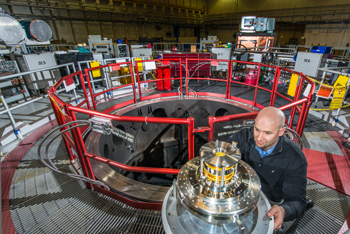The US Department of Energy’s (DOE) Ames Laboratory will acquire a Dynamic Nuclear Polarization-NMR spectrometer, a giant step forward in the laboratory’s solid state NMR capabilities.
The Ames Laboratory’s instrument will be the first of its kind to be focused on materials and materials chemistry in the United States.
In traditional nuclear magnetic resonance (NMR) technology, researchers are able to discover physical, chemical, electronic, and structural information about materials, based on the way atomic nuclei in the sample absorb electromagnetic radiation in a strong magnetic field.

paramagnetic resonance (EPR) spectroscopy with NMR, producing more sensitive,
rapid research results. Photo courtesy of Bruker.
Dynamic Nuclear Polarization (DNP)-NMR uses microwaves to polarize electrons, and then transfer that polarization from the electrons to the nuclei of the sample being analyzed.
“It’s essentially a combination of two techniques, electron paramagnetic resonance (EPR) spectroscopy with NMR, which yields an amazing increase in sensitivity,” said Cynthia Jenks, assistant director of scientific planning for the Ames Laboratory and director of chemical and biological sciences. “In the types of materials we use, we’ve been able to demonstrate an enhancement of anywhere from eight to 30 times in signal sensitivity. Results that used to take a week to obtain will now take hours or minutes.”
The increased capabilities of the DNP-NMR instrument will be in the hands of the lab’s six solid-state NMR scientists, and opens up possibilities for research that didn’t previously exist.
“Needless to say, we are all very pleased with this acquisition,” said Marek Pruski, the principal investigator of the research team. “The Ames Laboratory has an elite group of scientists specializing in the development and applications of solid-state NMR techniques. During the last 2 years we have conducted exploratory studies to demonstrate the critical importance of DNP NMR to our materials chemistry research, using the existing instrument in Lausanne, Switzerland and at the Bruker facility in Billerica, Mass. All these factors, and the critical support from the Ames Laboratory leadership made this outcome possible.”
Laboratory scientists expect the instrument to greatly expand and accelerate the progress of research efforts in many areas, including catalysis, nanocomposites, fuel cell membrane materials, soil organic matter, carbon electrode materials, plant cell walls, hydrogen storage materials and complex states.
The concept of DNP-NMR was first theorized and demonstrated in the 1950s at the University of Illinois, but it took decades of progress in microwave and NMR technology, mainly at MIT, to make a commercially produced instrument possible, only in the last three years.
The instrument, manufactured by Bruker, will be delivered and installed next year. The instrument is funded by DOE’s Office of Science, which supports fundamental research to understand, predict, and ultimately control matter and energy at the electronic, atomic, and molecular levels, in an effort to provide the foundations for new energy technologies and to support DOE missions in energy, environment, and national security.
The Ames Laboratory is a US Department of Energy Office of Science national laboratory operated by Iowa State University. The Ames Laboratory creates innovative materials, technologies and energy solutions. We use our expertise, unique capabilities and interdisciplinary collaborations to solve global problems.
DOE’s Office of Science is the single largest supporter of basic research in the physical sciences in the United States, and is working to address some of the most pressing challenges of our time. For more information, please visit science.energy.gov.



